Slow Fade, a free knitting pattern from Knitty.com. Free knitting pattern for a super-cool sock with cables mirrored from the right to the left.
INTRODUCTION
Slow Fade
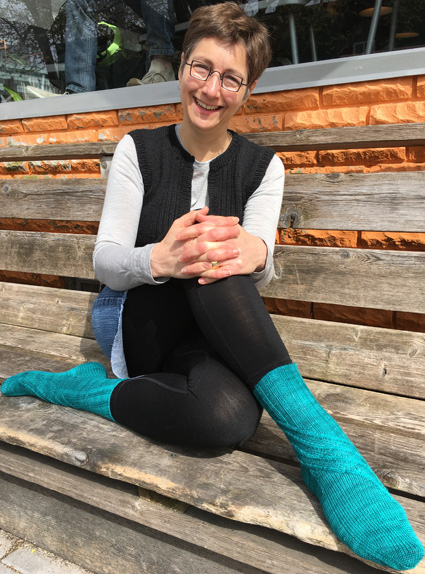
![]()
A ribbed sock fits nicely, but a ribbed sock can be a bit – dare I say it – dull to knit. This sock is not dull to knit, but equally not one where you have to keep consulting the charts. Once the pattern is established, it’s ridiculously straightforward to stay on track. In fact, this is one of those patterns that is harder to explain than do.
This design is worked top-down, with a flap and gusset heel, using a Dutch (Square) heel turn. I like this heel turn as it fits well, and it’s easier to create different sizes than for many others. I don’t by default work a slipped stitch heel pattern, because that’s not where I wear out my socks, but you can certainly do that if you wish.
In an attempt to keep Second Sock Syndrome at bay, there are different left and right socks. The pattern – as with all Knitty sock patterns – is written to permit use of DPNs, Magic Loop or Two Circulars, whichever method you prefer.
The sock uses my particular favourite no-graft toe. If you really feel that you need to close the toe with grafting, stop decreasing when about a third of the stitches remain – ensuring you have an even number of stitches. And if you’re a sock customizer, you can absolutely use a different heel turn, but I strongly recommend a flap-and-gusset heel. The stitch pattern takes away a little of the stretchiness of the fabric and a short-row type of heel won’t fit the vast majority of feet.
 model: Kate Atherley
model: Kate Atherley
 photos: Amy Singer
photos: Amy Singer
SIZE
Adult XS[S, M, L, XL, XXL]
FINISHED MEASUREMENTS
Foot circumference: 6.25[7, 7.25, 8, 8.25, 8.75] inches/ 16[18, 18.5, 20.5, 21, 22] cm
Leg length: adjustable
Foot length: adjustable
Note: The cables make this fabric slightly less stretchy - choose a size with approximately 0.75 inch/2 cm negative ease.
MATERIALS
![]() CaribouBaa [100% superwash merino; 435yd/398m per 100 g skein]; color: Teenage Dauphin Club, 1 skein
CaribouBaa [100% superwash merino; 435yd/398m per 100 g skein]; color: Teenage Dauphin Club, 1 skein
Recommended needle size
[always use a needle size that gives you the gauge listed below - every knitter's gauge is unique]
![]() US #1.5/2.5mm needles for small circumference in the round: DPNs, 1 long circular for magic loop, or 2 short circulars
US #1.5/2.5mm needles for small circumference in the round: DPNs, 1 long circular for magic loop, or 2 short circulars
Notions
![]() (optional) cable needle
(optional) cable needle
![]() yarn needle
yarn needle
GAUGE
32 sts/48 rounds = 4 inches/10 cm in stockinette stitch
PATTERN NOTES
[Knitty's list of standard abbreviations and techniques can be found here.]
This pattern's instructions were revised June 26/17 to make them easier to follow. Changes are marked in pink below. The chart has also been revised.
Instructions for the Long-Tail Cast On can be found here.
C2/1L: Slip next 2 sts to cable needle and hold in front of work; k1, then k2 from cable needle.
C2/1R: Slip next st to cable needle and hold in back of work; k2 then k1 from cable needle.
T2/1L: Slip next 2 sts to cable needle and hold in front of work; p1, then k2 from cable needle.
T2/1R: Slip next st to cable needle and hold in back of work; k2 then p1 from cable needle.
Construction notes:
This sock pattern is easier to knit than it is to write up: basically, just keep the cables lined up! The placement of the cable motif shifts over 1 stitch every two rounds.
The Left sock starts with the cable motif at the start of the round, and it travels left around the leg and foot as you work. The Right sock starts with the cable motif at the end of the round, and it travels right around the leg and foot as you work.
As the cable motif travels, it ‘eats up’ the ribbing stitches, and leaves stockinette stitch established behind it. Once all the ribbing stitches have been consumed, work the stitches outside the cable motif in stockinette.
While working the leg, there’s no need to keep track of the start of the round. Rearrange your stitches or use markers as you prefer to help you stay lined up.
The heel position is set by the position of the cable motif, which accommodates any leg length you wish.
CHARTS
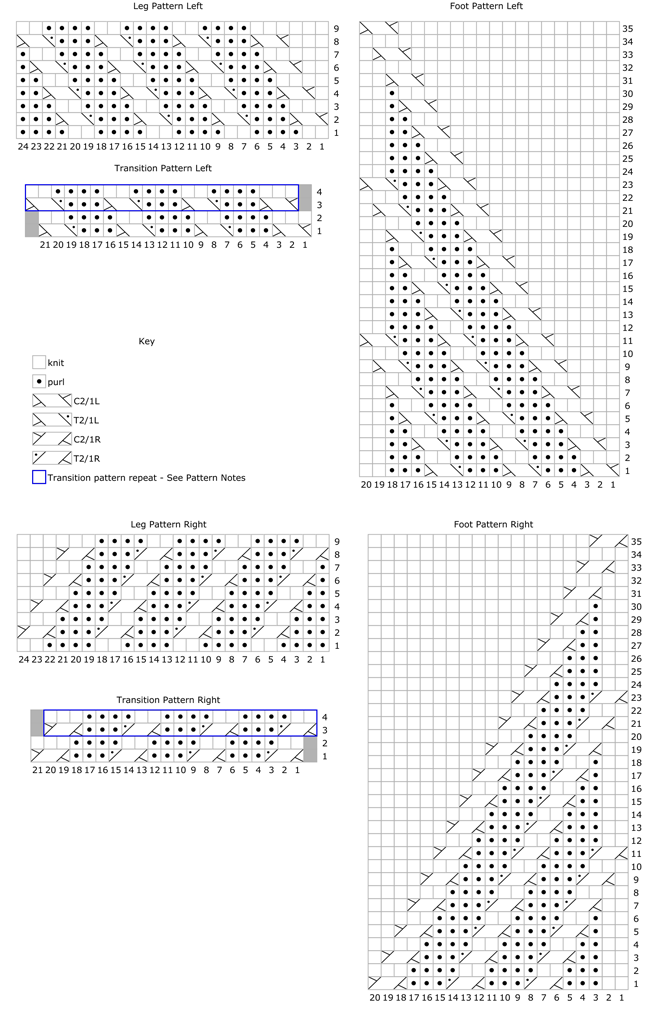
DIRECTIONS
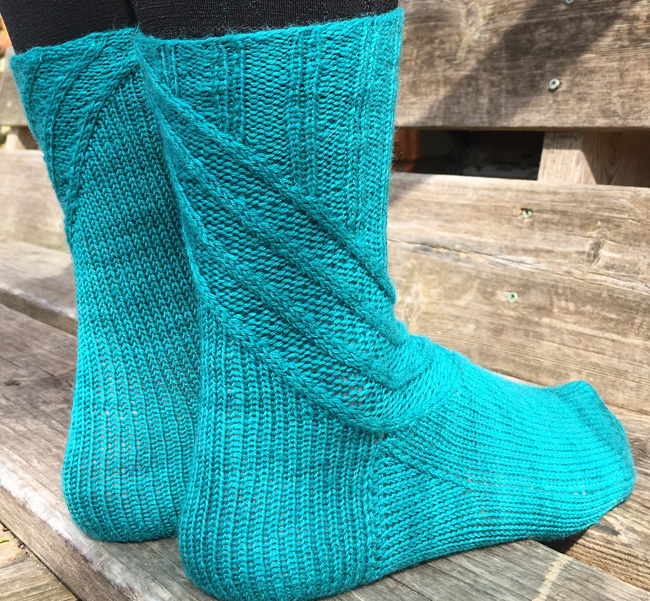
FIRST SOCK (Left-Leaning)
Cuff
Using your favorite stretchy method (Long Tail or German Twisted), CO 54[59, 64, 69, 74, 79] sts. Distribute sts across needles as you prefer and join for working in the round.
Upper Leg round: Work Leg Pattern Left Chart Round 1 across first 24 sts, (k2, p3) to end of round.
Work as set until you have completed Chart Round 9.
Setup for chart repeat: K4. You’ll start working the Transition chart at this point. If you wish, rearrange your stitches or place a marker to keep track of chart position. You don’t need to keep track of the start of the round, only the chart position, the cable motif.
Leg repeat round 1: K to chart position, work Transition Pattern Left across next 21 sts, work ribbing as set to end of round.
Leg repeat round 2: K to chart position, work Transition Pattern Left across next 21 sts, work ribbing as set to end of round.
Once you’ve worked these two rounds, the position of the chart moves over by 1 stitch – further away, towards the end of the round – as shown in the change between rounds 2 and 3 in the Transition chart. Put another way, every time you work Round 3, there will be 1 more stitch to knit between the start of the round and the start of the chart.
Continue, repeating Transition Pattern Left Rounds 3-4, moving the chart over by 1 st every 2 rounds, until leg measures desired length, ending with an odd-numbered chart round.
If and when you hit the point where all the ribbing stitches have been ‘consumed’, all stitches outside the 21 of the chart will be working in stockinette stitch. You might not have completed this when you start the heel, that’s fine!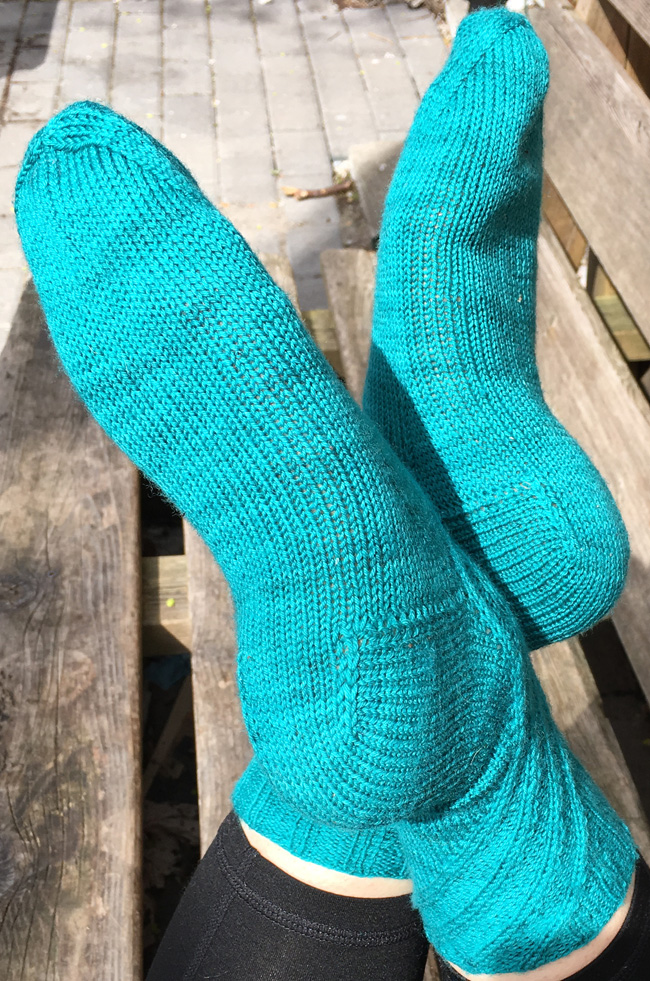
Heel Flap
Setup for Heel: K to just before the first cable turn.
This position is the start of the instep, placing the cable motif on the far right of the instep. The heel is worked on the 28[28, 30, 32, 34, 36] sts just worked; rearrange sts as you prefer.
Turn so that WS is facing.
Heel flap row 1 [WS]: P 28[28, 30, 32, 34, 36] , turn.
Heel flap row 2 [RS]: Sl 1 pwise wyib, k 27[27, 29, 31, 33, 35] , turn.
Heel flap row 3 [WS]: Sl 1 pwise wyif, p 27[27, 29, 31, 33, 35] , turn.
Repeat Heel flap rows 2-3 11[12, 13, 14, 15, 16] more times.
Heel Turn
Heel turn row 1 [RS]: K 19[19, 20, 21, 23, 24] , ssk, turn.
Heel turn row 2 [WS]: Sl 1 pwise wyif, p 10[10, 10, 10, 12, 12] , p2tog, turn.
Heel turn row 3 [RS]: Sl 1 pwise wyib, k 10[10, 10, 10, 12, 12] , ssk, turn.
Heel turn row 4 [WS]: Sl 1 pwise wyif, p 10[10, 10, 10, 12, 12] , p2tog, turn.
Repeat Heel turn rows 3-4 until all heel stitches have been worked. 12[12, 12, 12, 14, 14] sts rem.
Gusset Read before you begin: Continue working the Transition Pattern Left as set, moving the chart position over 1 stitch every 2 rounds, as per the Leg. It doesn’t matter whether ribbing stitches remain or not.
When the cable motif pattern hits the far left of the instep – that is, when you’ve got 5[10, 13, 16, 19, 22] knit stitches before 21-stitch cable motif, start working the Foot chart in its place, once again moving the chart position over 1 stitch before you begin. Once the Foot chart is complete, knit all stitches.
Gusset setup round 1: K 12[12, 12, 12, 14, 14] heel sts. With RS facing, pick up and knit 14[15, 16, 17, 18, 19] sts along first edge of heel flap; work across instep in pattern as set, pick up and knit 14[15, 16, 17, 18, 19] sts along second edge of heel flap, k 6[6, 6, 6, 7, 7] to center of heel. This position is the new start of round. Rearrange sts and place markers as required. 66[73, 78, 83, 90, 95] sts.
Gusset setup round 2: K 6[6, 6, 6, 7, 7] , k 14[15, 16, 17, 18, 19] tbl, work across instep in pattern as set, k 14[15, 16, 17, 18, 19] tbl, k to end of round.
Gusset round 1: K to 3 sts before instep, k2tog, k1; work across instep in pattern as set, k1, ssk, k to end of round. 2 stitches decreased.
Gusset round 2: Work even in pattern as set.
Repeat Gusset rounds 1-2 6[7, 8, 8, 10, 10] more times, until 52[57, 60, 65, 68, 73] sts remain.
Work even, completing chart patterns and then continuing in stockinette st, until foot measures 1.5[1.5, 1.5, 1.75, 2, 2] inches/ 4[4, 4, 4.5, 5, 5] cm short of desired final foot length.
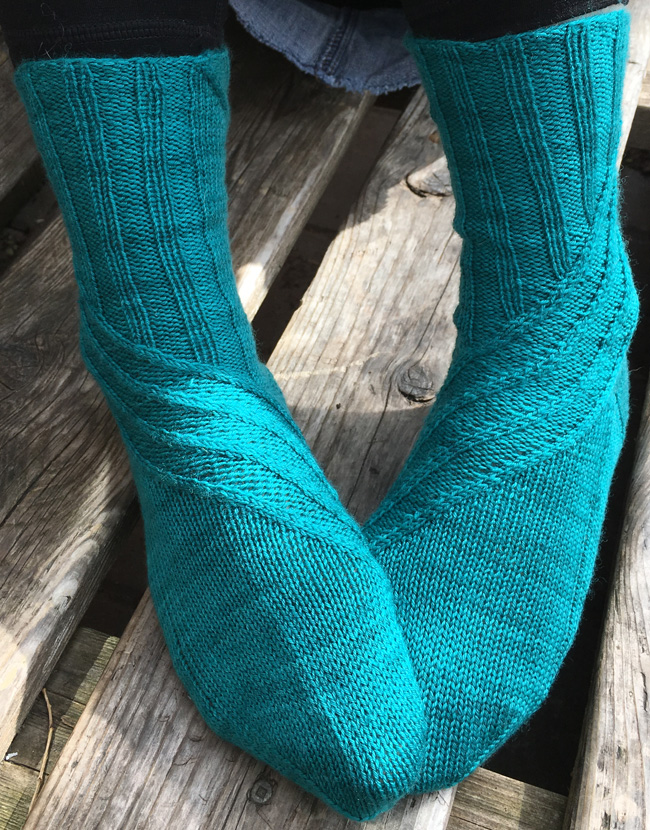
Toe
To set up for toe decrease, rearrange your stitches so that you have 26[29, 30, 33, 34, 37] sts on the instep, and 26[28, 30, 32, 34, 36] sts on the sole.
Decrease round: K to 3 sts before instep, k2tog, k1; k1, ssk, k to 3 sts before end of instep, k2tog, k1; k1, ssk, k to end of round. 4 sts decreased.
Following round: Knit.
Repeat the last 2 rounds 5[5, 6, 6, 7, 7] times.
Work the Decrease round 5[6, 6, 7, 7, 8] times. 8[9, 8, 9, 8, 9] sts remain.
Cut yarn and pull through final sts to secure.
SECOND SOCK (Right-Leaning)
Cuff
Using your favorite stretchy method (Long Tail or Twisted German), CO 54[59, 64, 69, 74, 79] sts. Distribute sts across needles as you prefer and join for working in the round.
Upper Leg round: (P3, k2) to last 24 sts, work Leg Pattern Right Chart Round 1 to end of round.
Work as set until you have completed Chart Round 9.
Leg repeat round 1: Work ribbing as set to chart position, work Transition Pattern Right across next 21 sts, k to end of round.
Leg repeat round 2: Work ribbing as set to chart position, work Transition Pattern Right across next 21 sts, k to end of round.
Once you’ve worked these two rounds, the chart moves over by 1 stitch– closer to the start of the round – as shown in the change between rounds 2 and 3 in the Transition chart. Put another way, every time you work Round 3, there will be 1 fewer stitch to work in ribbing between the start of the round and the start of the chart.
Continue, repeating Transition Pattern Right Rounds 3-4, moving the chart over by 1 st every 2 rounds, until leg measures desired length, ending with an odd-numbered chart round.
If and when you hit the point where all the ribbing stitches have been ‘consumed’, all stitches outside the 21 of the chart will be working in stockinette stitch. You might not have completed this when you start the heel, that’s fine!
Heel Flap
Setup for Heel: Work in pattern as set to just after the last cable turn.
This position is the end of the instep, placing the cable motif on the far left of the instep. The heel is worked on the next 28[28, 30, 32, 34, 36] sts; rearrange sts as you prefer.
Heel flap row 1 [RS]: K 28[28, 30, 32, 34, 36] , turn.
Heel flap row 2 [WS]: Sl 1 pwise wyif, p 27[27, 29, 31, 33, 35] , turn.
Heel flap row 1 [RS]: Sl 1 pwise wyib, k 27[27, 29, 31, 33, 35] , turn.
Heel flap row 2 [WS]: Sl 1 pwise wyif, p 27[27, 29, 31, 33, 35] , turn.
Repeat Heel flap rows 3-4 11[12, 13, 14, 15, 16] more times.
Heel Turn
Work as for Left Sock.
Gusset Read before you begin: Continue working the Transition Pattern Right as set, moving the chart position over 1 stitch every 2 rounds, as per the Leg. It doesn’t matter whether ribbing stitches remain or not.
When the cable motif pattern hits the far right of the instep – that is, when you’ve got 5[10, 13, 16, 19, 22] knit stitches after the 21-stitch cable motif, start working the Foot chart in its place. Once the Foot chart is complete, knit all stitches.
Continue as per Left Sock, starting with Gusset setup round 1.
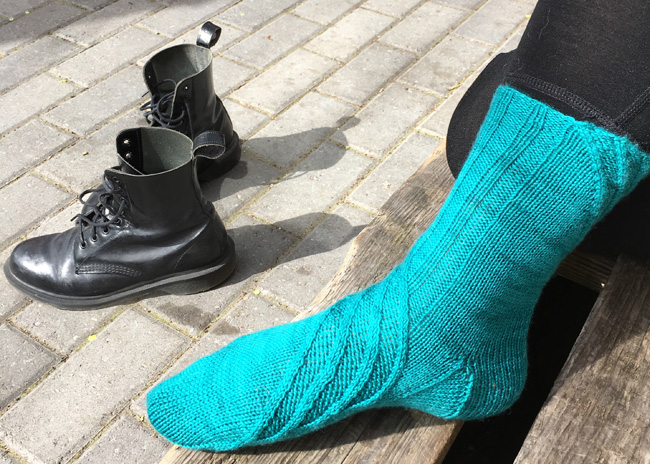
FINISHING
Wash to block and weave in ends.
ABOUT THE DESIGNER
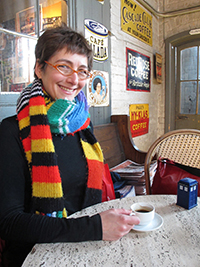 Kate is rather a fan of interesting socks that fit well. Did you know she wrote a whole book about it?
Kate is rather a fan of interesting socks that fit well. Did you know she wrote a whole book about it?
You can see more of her work at kateatherley.com, and on Ravelry.
Pattern © 2017 Kate Atherley, images © Amy Singer. Contact Kate